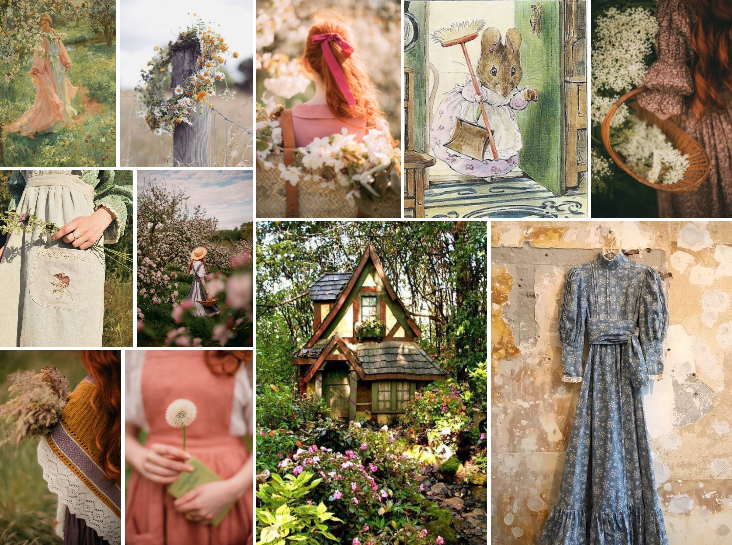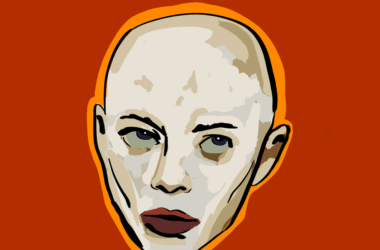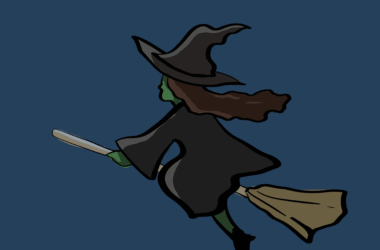Tweed peacoats, plaid dresses, corsets, and cutlasses found discarded in antique store basements have attracted a new group of buyers in 2021: Teenagers.
“Aesthetics,” a branch of philosophy that studies the nature and qualifications of beauty, taste, and art, has been given a whole new meaning in the last decade by Gen Z social media users. The contemporary understanding of the term has completely changed to now align with a collection of visuals that represent a broad array of concepts ranging from historical eras, locations, genres of fiction, music, and even pre-existing subcultures. The most prevalent of 2021 aesthetics can be narrowed down to two categories: Cottagecore, an aesthetic that romanticizes cottage life, and Dark Academia, a style that engages in the eerie visuals of early 20th-century academia. As these two aesthetics—along with many other similar aesthetics—gain popularity in the online lives of young people, it becomes important to understand how they arose, what they are, and what their modern-day implications may be.
For starters, Tumblr might have a few answers. Created in 2007, Tumblr was the first image-oriented social media platform to go mainstream. Pinterest and Instagram, both launched in 2010, followed soon after. Unlike its other social media predecessors, the platform centered around users’ ability to create a distinct visual identity by curating their blog with an individualized colour scheme and font palette, along with the reblogging of content. Zoe Karkossa, U4 Science, has avidly tracked the development of Tumblr aesthetics since she started her blog in 2013.
“Tumblr was the first platform to really capitalize on the use of visual images as symbols,” Karkossa said. “You had Flickr [before], but that was […] meant to be photos that you took. [On] Tumblr, you had the option of curating […] images that other people have taken.”
Karkossa argues that Tumblr provided access to a huge database of pictures and GIFs, which made certain recurring images, products, and color schemes popular among users. Before the white, upper-middle class VSCO blogger aesthetic, there were “basic” bloggers who drank Starbucks, wore Uggs, and posted highly stylized inspirational quotes on Instagram. While older millennials were evolving from the Scene kids of MySpace into early 2010s Hipsters, younger millennials and Gen Z-er’s were building off of the styles on these online platforms to curate their own visual identities.
Beyond curating moodboard blogs, Tumblr was ultimately a fan-centric space. Teens on 2012-2014 era Tumblr created fandoms surrounding YouTubers, bands, shows, and even authors. With so many people discussing the same content—whether it was the Arctic Monkeys AM, Troye Sivan and Tyler Oakley’s “Boyfriend Tag” video, or the unforgettable Mishapocalypse—certain fashion styles also gained popularity on the website, like galaxy leggings and flower crowns. In turn, the mainstream “basic” aesthetic contended with a newer, though no less homogenous, fandom aesthetic.
Carrie Rentschler, an associate professor at McGill’s Department of Art History & Communication Studies who studies aesthetics through the lens of social media activism, noted that social media users must be aware of how different websites provide different avenues of expression for their creators. An aesthetic develops when certain visuals can move between different platforms, adapting in accordance to the new websites.
“There is a kind of […] revision process that aesthetics are going through as part of the creative process,” Rentschler said. “You have this corpus of material on social media and cross-platform movement of […] emerging aesthetics and […] conventions. [Content creators have] a way of doing things that is not directly agreed upon [but rather, they] have chosen to make similar decisions.”
Whereas Tumblr provided anonymity through its reblogging function—allowing the creation of a visual identity to be developed sans ownership—Instagram shifted visual communication toward a form of individualized social signalling. Instagram users do not simply curate content, they create it. The images an individual posts on Instagram—like the Helvetica-filtered early 2010’s circle of shoes photo—signified, to some extent, the fashion that they subscribed to and the internet subculture they were a part of. Simultaneously, Pinterest users can curate their style by searching up images and creating boards. Not long after, Instagram pages with moodboards followed.
It should come as no surprise, then, that the aesthetics that originated on Tumblr and were popularized through Instagram have taken TikTok by storm. The significance of aesthetics, however, lies not in their existence, but in their unexpected mainstream appeal, global influence, and escapist nature.
No aesthetic is perhaps as escapist as Cottagecore, a theme that originated on Tumblr in 2017—although arguably popularized by Marie Antoinette—and presents a romanticized version of rural life, complete with green-coated fields, airy dresses, flowers, woven baskets, self-subsistence, and frolics through mystical fields. While it is an undeniably beautiful and otherworldly aesthetic that has sprouted many offshoots of its own, Cottagecore also has complicated socio-political undertones. It upholds a conservatively traditional lifestyle, yet at the same time is championed by queer women who find sapphic appeal in a sustainable, unpreturbed, romantic pastoral life. Furthermore, it idolizes anti-capitalism in its pursuit of self-subsistence, but is inherently consumerist in its pursuit of a certain lifestyle—it takes money to be able to buy an array of vintage dresses, curate a charcuterie board, and to even have the time to frolic in a field.
Even so, the Cottagecore aesthetic holds no malicious intent, and provides the viewer a flower-spotted escape from a complicated and stressful world. Taylor Swift’s release of two Cottagecore-themed albums in 2020 has pushed the aesthetic into the mainstream.
On the other end of the optical and atmospheric spectrum is Dark Academia, a neoclassicist subset of the larger “Academia” aesthetic which focusses on a certain macabre, academically rigorous, elite university lifestyle, reminiscent of Donna Tartt’s The Secret History. Think studying in a coffee-stained sweater vest, hidden in the nook of a snowed-in library, while you pore over an ancient Greek text to the sound of Vivaldi far off in the distance.
Jesse Smith, U1 Arts and TikTok content creator, delves into the details of their preferred aesthetic: Dark Academia.
“Whereas Cottagecore is Midsommar without the horror […], Dark Academia is very Dead Poets Society, Good Will Hunting, [and] to an extent, Harry Potter,” Smith said. “A lot of the aesthetic has the undertones of nefariousness. You want to create a secret society with your friends and hide murder. That is not actually something you want to do, but that’s the vibe you’re going for.”
What both of these aesthetics have in common is that they provide young people a form of unique self-expression and a way to elude a world filled with death, disease, racialized violence, and political turmoil. Smith argues that Dark Academia ultimately boils down to self-expression and a growing opposition to the conventions and practices of the fashion industry.
“We have a lot more of an opportunity, and a willingness to not conform,” Smith said. “A lot of the movement towards aesthetics is against the fashion industry [because] aesthetics can’t be mass produced in the quality people are looking for. Fashion aesthetics have moved the younger generations more towards thrifting and higher quality clothing [….] People care a lot more about how they feel in their clothing rather than how that clothing presents them to the world.”
Maybe the emergence of these strange subcultures is for the best: Pushing against fast fashion, pursuing a unique sense of self-expression in lockdown, and looking for a fantastical form of escape are arguably some of the best things young people can be doing right now. When the world feels like it is on fire, there is nothing wrong with putting on a flowy dress, closing your eyes, and thinking of a life where a trickling stream, a bloom of lily flowers, and a homemade meal await you by a cottage on a hill. Maybe you will even find yourself along the way.







